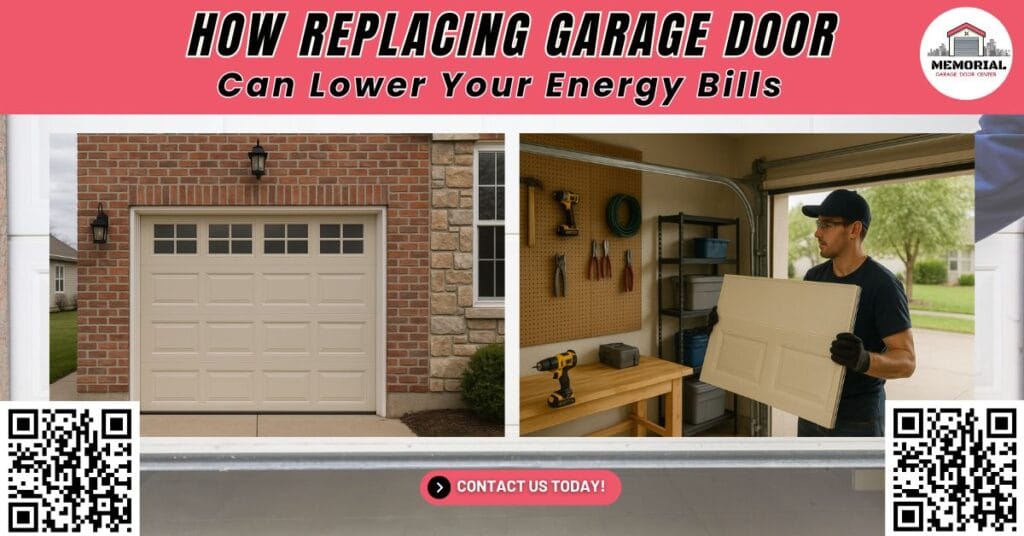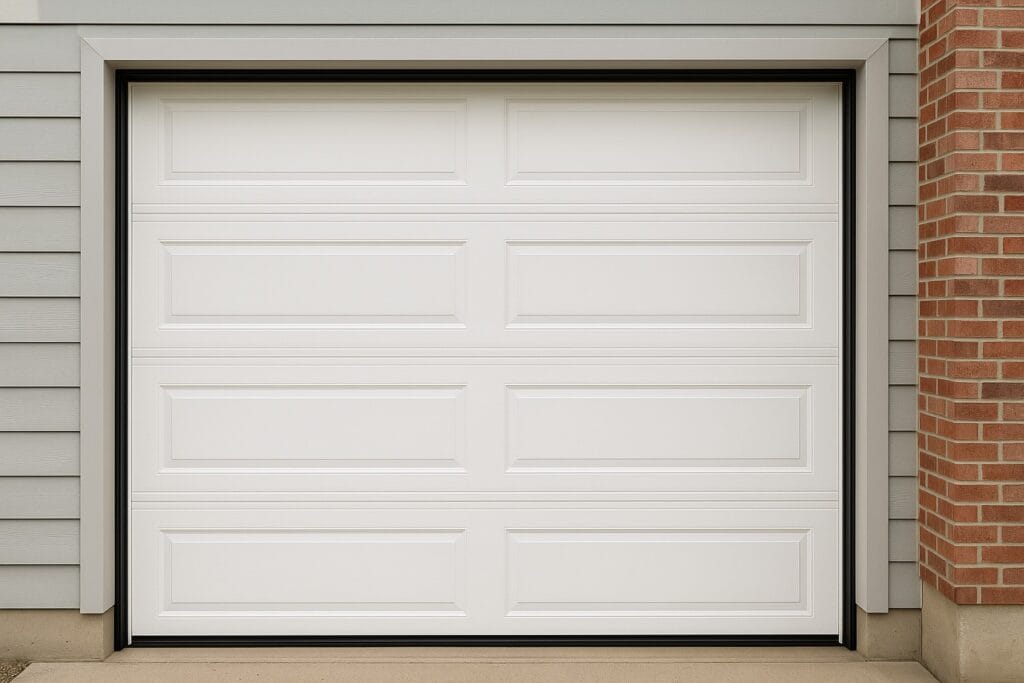Replacing Garage Door: How It Can Lower Your Energy Bills

A family in Houston recently called Memorial Garage Door Center with a problem: their garage was sweltering in the summer, freezing in the winter, and it was impacting their entire home’s comfort. Their energy bills kept climbing despite their HVAC system working overtime. Our technicians inspected their existing garage door system and found it was outdated, lacked insulation, and had significant air leaks along the vertical tracks and bottom panels. After replacing garage door with a modern, insulated model equipped with a new garage door opener and reinforced torsion springs, they noticed an immediate difference in more stable temperatures and a nearly 20% reduction in monthly energy bills.
If you’re still living with an old, non-insulated door, you’re not alone. According to the U.S. Department of Energy, 30% of home energy loss occurs through gaps and poorly insulated areas like windows, doors, and, yes, your garage door. For many homeowners in Houston and surrounding areas, the garage is either attached to the house or directly beneath important rooms. A drafty garage can cause your HVAC system to work harder, raising your utility bills unnecessarily.
At Memorial Garage Door Center, we specialize in both residential and commercial garage door services, offering expert garage door installation, maintenance, and repairs. When it comes to improving energy efficiency and reducing bills, replacing garage door systems is one of the smartest investments you can make.
Why Garage Doors Matter for Energy Efficiency
Your garage door isn’t just for security, it’s also a large part of your home’s thermal envelope. An old or poorly insulated garage door allows heat and cold to pass freely, disrupting the controlled indoor climate. This is especially true for residential garage doors that share walls with living spaces like bedrooms or offices.
Outdated garage doors often have worn hinges, cracked panels, degraded weather seals, and rusted brackets. These flaws cause air leaks and poor insulation, which ultimately lead to higher energy usage. Even small gaps around the horizontal tracks or under the bottom panel allow temperature changes to seep in.
When your HVAC system works harder to make up for this energy loss, it consumes more electricity or gas. That’s not only costly, it’s also harmful to the environment. Energy-efficient garage doors help conserve energy by keeping the outside temperatures where they belong: outside.
Benefits of Replacing Garage Door for Lower Energy Bills
1. Advanced Insulation Materials and High R-Values
New garage door panels come with polyurethane or polystyrene insulation. These materials trap air and prevent heat transfer, boosting your garage door’s R-value. An R-value measures how well a material resists heat flow; the higher the value, the better the insulation.
For Houston’s hot climate, we often recommend doors with R-values of 13 or higher. These doors can significantly reduce the temperature swings in your garage, especially when paired with a properly installed garage door opener that ensures smooth operation and a tight seal.
2. Sealed Edges and Modern Weatherstripping
The gap between the garage door and the floor is a common problem area. New garage doors are fitted with weather seals along the bottom panel, header, and side brackets to prevent air leakage, water, and even pests from entering the garage.

A proper seal also keeps your insulation from being compromised. Professional installation ensures that the garage door brackets, flag brackets, and track systems are aligned correctly for a complete seal and better energy conservation.
3. Energy-Efficient Garage Door Opener Systems
Many homeowners overlook the garage door opener, but it plays a vital role in energy efficiency. Modern openers allow for automatic closing, use LED lighting, and can integrate with smart home systems to send alerts if the garage door is left open. Less exposure means less air exchange, which keeps your garage at a consistent temperature.
Upgraded openers also feature soft start and stop features, which reduce wear on torsion springs, hinges, and tracks, lowering your long-term maintenance costs and contributing to the smooth operation of your system.
How Garage Door Replacement Helps Homes and Businesses
Whether you own a single-family home, run a commercial warehouse, or manage a retail space, energy costs are a concern. For homes, poor insulation and thin garage door panels cause temperature imbalances. For businesses, especially those with large commercial doors that open and close frequently, energy loss can lead to skyrocketing expenses.
For Homes:
- Keeps garage-adjacent rooms comfortable
- Reduces HVAC system strain
- Increases curb appeal and home value
For Businesses:
- Helps maintain product storage temperatures
- Reduces utility bills for climate-controlled facilities
- Enhances security with reinforced hinges, locks, and torsion tube systems
Replacing garage door systems ensures energy isn’t wasted during daily use. With horizontal and vertical track alignment, torsion spring systems, and proper panel insulation, businesses can enjoy both functionality and savings.
Added Perks of Replacing Garage Door
1. Noise Reduction
New garage doors with proper insulation and smooth, lubricated hinges offer quieter operation, perfect for homes with bedrooms or offices near the garage. Insulated panels reduce noise transmission from outside, creating a more peaceful indoor space.
2. Increased Security
New garage door systems feature stronger locking mechanisms, updated brackets, and smart openers that enhance protection. Whether you choose a DIY install or opt for professional installation, security should always be a priority.
3. Weather Resistance
Houston weather can be unpredictable. High winds, rain, and temperature extremes test your garage door’s durability. Modern doors are engineered with wind-load resistance, galvanized steel panels, and tight-fitting brackets and tracks to withstand the elements.
4. Less Maintenance and Upkeep
Modern materials like vinyl-coated steel or composite wood require less upkeep than older doors. Say goodbye to constant tightening of bolts and screws or reapplying sealant. New systems are designed for long-term durability, reducing both hassle and cost.
How to Choose the Right Garage Door for Energy Efficiency
When replacing garage door systems, keep the following in mind:
- Material: Steel with foam insulation offers the best energy savings.
- Insulation Type: Choose polyurethane (higher R-value) over polystyrene.
- Panel Design: Multiple garage door sections create better seals.
- Torsion Springs: More durable than extension springs and better for insulation and balance.
- Seals: High-quality bottom, side, and top seals block airflow.
- Installation Process: Always follow professional installation instructions or hire trained technicians to ensure safe operation.

For DIY enthusiasts, having the right tools such as a vise grip, power drill, screws, and proper brackets is critical. But due to the complexity of aligning the torsion tube, spring tension, and track system, professional garage door installation is often safer and more efficient.
Real Houston Success Story: Saving with Smart Garage Door Installation
In the Rice Military area of Houston, a client wanted to turn their garage into a gym but couldn’t manage the temperature. After inspecting their door, we found thin metal panels and no insulation. Our technicians installed a new, insulated garage door with high R-value foam core panels, replaced the torsion spring system, and added a smart opener.
The result? Their garage stayed cool even during 100°F days. Their home’s AC usage dropped, and their electric bill fell by 18%. They also loved the sleek, modern look of their new garage door.
How Can Memorial Garage Door Center Help You?
At Memorial Garage Door Center, we offer more than just garage door repairs; we provide energy-efficient solutions designed to save you money and keep your home comfortable. Our services in Houston, TX, include:
- ✅ New Garage Door Installation (residential & commercial)
- ✅ Garage Door Opener Replacement
- ✅ Garage Door Insulation Upgrades
- ✅ Torsion Spring & Track Alignment
- ✅ Custom Door Solutions with Smart Technology
Our expert technicians follow a step-by-step guide to ensure safe, secure, and successful garage door installation using industry-best practices and materials. Whether you need help choosing the right garage door, updating an older system, or installing advanced insulation, we’re ready to serve you.
📍 Visit us at: 2417 Sabine St, Houston, TX 77007
📞 Call us now: (281) 720-3113
🌐 Don’t let an outdated garage door drain your wallet. Schedule your energy-saving upgrade with Memorial Garage Door Center today!
Frequently Asked Questions (FAQs)
1. How much can I expect to save on energy bills after replacing my garage door?
Most homeowners can expect to save between 10% to 20% on their energy bills, depending on the quality of insulation and how connected the garage is to the main living space.
2. Is it worth insulating a detached garage door?
Yes, insulating a detached garage helps protect stored items, reduces noise, and improves comfort if the space is used as a workshop or home gym.
3. How long does it take to replace a garage door for better insulation?
A professional garage door replacement typically takes 4 to 6 hours, includingthe removal of the old door, installing the new one, and testing all systems.
4. Can I add insulation to my existing garage door instead of replacing it?
You can, but it’s usually less effective than a purpose-built insulated door and may not seal properly, which limits the energy-saving benefits.
